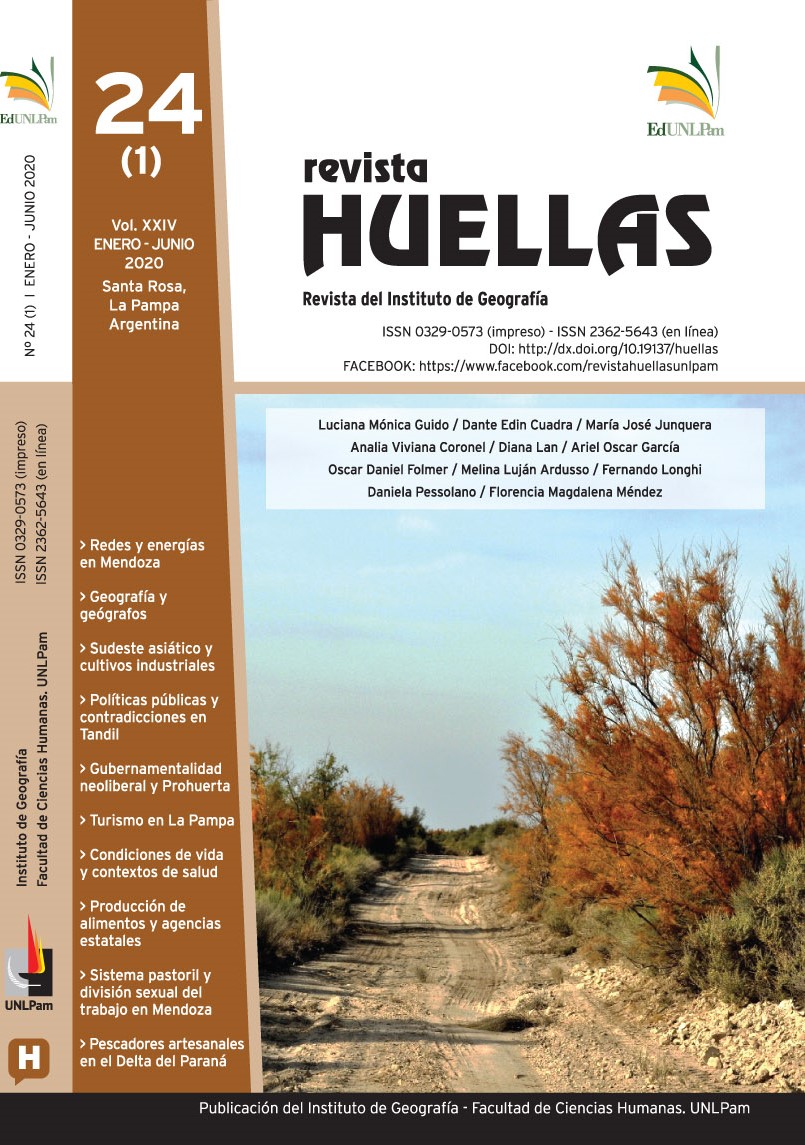Expansion of Industrial crops in Southeast Asia: The case of the oil palm in Indonesia and Malaysia
Keywords:
oil palm, industrial agriculture, Southeast Asia, food sovereigntyAbstract
The oil palm or African palm (Elaeis guineensis) is a native plant of West Africa. In recent decades, approximately since the sixties, this crop has experienced significant growth in the tropical regions of the southern hemisphere, as a monoculture for the production of vegetable oils for export. Within a context in which oil palm cultivation is expanding into new regions of the world, such as Africa and Central America, research aims to identify the social and environmental problems that the development of industrial oil palm crops has had in the two main oil palm producing countries in the world: Indonesia and Malaysia. It is hypothesized that the expansion of industrial monoculture of oil palm is inserted in the current extractivist paradigm of appropriation of natural resources worldwide; also, that it is responsible for the massive deforestation of tropical forests in Southeast Asia; and that, therefore, it endangers the food sovereignty of the countries of Southeast Asia, by displacing family farming and traditional food crops. The methodology consisted in the survey of academic sources and reports of international organizations and NGOs.
Downloads
References
Amnistía Internacional. (2016). El gran escándalo del aceite de palma: abusos laborales detrás de grandes marcas. Resumen ejecutivo. Recuperado de https://amnistia.org.ar/wp-content/uploads/delightful-downloads/2016/12/321518416.spa-J2366_NOV16-Palm-oil-executive-summary.pdf
D’Enghien , P. (Febrero, 2016). Palm Oil- Essential for Food Security. Recuperado de http://theoilpalm.org/palm-oil-essential-for-food-security/
Food and Agriculture Organization of the United Nations (FAO). (1977). Modern oil palm cultivation. En FAO. The Oil Palm. Roma: Autor. Recuperado de http://www.fao.org/3/t0309e/T0309E00.htm#TOC
Food and Agriculture Organization of the United Nations (FAO). (2015). Evaluación de los recursos forestales mundiales 2015. Compendio de datos. Recuperado de http://www.fao.org/3/a-i4808s.pdf
Geografía de las sociedades humanas. (1981). Barcelona: Planeta.
Giarraca, N. & Teubal, M. (2010). Disputas por los territorios y recursos naturales: el modelo extractivo. Revista ALASRU-Nueva Época, n°5, pp. 113-133.
González Sáez, R. (2012). ASEAN 2020: ¿Una Comunidad?. Fundación de Investigaciones Sociales y Políticas. Recuperado de https://fisyp.org.ar/article/asean-2020-una-comunidad/
GRAIN. (2014). La soberanía alimentaria a la venta. Recuperado de https://www.grain.org/es/article/5073-la-soberania-alimentaria-a-la-venta
GRAIN. (2015). Los tratados de libre comercio impulsan el cambio climático: el factor alimentario. Recuperado de https://www.grain.org/article/entries/5319-los-tratados-de-libre-comercio-impulsan-el-cambio-climatico-el-factor-alimentario
GRAIN. (2016). El control del sistema alimentario. En GRAIN & Moreno, D. (eds.). El gran robo del clima. Por qué el sistema agroalimentario es motor de la crisis climática y qué podemos hacer al respecto (pp. 188-245). Ciudad de México: Itaca.
https://oec.world/es/profile/sitc/4242/
Lim, K., Goh, K., Kee, K. & Henson, I. Climatic requirements of oil palm. En Goh, K., Chiu, S. & Paramananthan, S. (eds.). Agronomic Principles And Practices Of Oil Palm Cultivation. Petaling Jaya, Malasia: Agricultural Crop Trust.
Movimiento Mundial por los Bosques Tropicales (WRM). (2001). El amargo fruto de la palma aceitera: despojo y deforestación. Montevideo, Uruguay: Autor.
Movimiento Mundial por los Bosques Tropicales (WRM). (2014). Nuevas tendencias en la expansión de los monocultivos industriales de árboles en América Latina. Montevideo, Uruguay: Autor.
Movimiento Mundial por los Bosques Tropicales (WRM). (Junio, 2013). 12 respuestas a 12 mentiras sobre los monocultivos de palma aceitera. Recuperado de https://wrm.org.uy/es/libros-e-informes/12-respuestas-a-12-mentiras-sobre-los-monocultivos-de-palma-aceitera/
National Geographic. (2004). ATLAS National Geographic: Asia (Tomo II). Perú: Planeta DeAgostini.
OCDE/FAO. (2017). Sudeste Asiático: Perspectivas y retos. En OCDE-FAO Perspectivas Agrícolas 2017-2026 (pp. 67-109). París: OECD Publishing. DOI: http://dx.doi.org/10.1787/agr_outlook-2017-5-es
Omoti, U. (2004). La palma de aceite en África: evolución durante la última década, tendencias y nuevos retos. Revista Palmas, Vol. 25 No. Especial, Tomo I, pp. 147-169.
Population Reference Bureau (PRB). (2019). International Data. Southeast Asia.
Recuperado de https://www.prb.org/international/geography/southeast-asia
Sigaudo, D. y Terre, E. (Diciembre, 2018). El mercado mundial de aceites vegetales: situación actual y perspectivas. Informativo Semanal de la Bolsa de Comercio de Rosario. Recuperado de https://www.bcr.com.ar/es/mercados/investigacion-y-desarrollo/informativo-semanal/noticias-informativo-semanal/el-mercado-10
The Observatory of Economic Complexity (OEC). (2017). Aceite de palma trade. Recuperado de https://oec.world/en/profile/hs92/1511/
Unión Europea. (Septiembre, 2019). EU's Renewable Energy Directive & its impact on Palm Oil. Recuperado de https://eeas.europa.eu/headquarters/headquarters-homepage/53721/palm-oil-kelapa-sawit_en
United Nations Environment Programme (UNEP). (2016). Annual Report 2015. Recuperado de https://www.unenvironment.org/annualreport/2015/en/index.html
Vía Campesina. (27 de febrero de 2007). Declaración de Nyeleni. Nyéléni, Selingue, Malí. Recuperado de https://nyeleni.org/spip.php?article291
Zavala, R. (2016). Una visión general a las características del sector de la palma de aceite. Revista Palmas, Vol. 37 No. Especial, Tomo II, pp. 287-291.






.png)












3.jpg)


